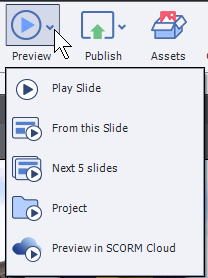
Selecting a way to record the results of your elearning and capturing data about your students is not a decision you should rush to. Here’s a video that showcases some key features of Adobe Captivate Prime: Don’t Forget For example, if you offer initial training to your customers but will likely not see them return for additional training in the future. This is useful if you offer short-term access to your training. They also allow for an option to only bill you for monthly active users. There is a minimum of ten users but at only $4 per user, it’s affordable for even the smallest of organizations. Rather than charging you a flat fee, they charge you only for the learners you have. One of the things about Adobe Captivate Prime that I really like is the scalability they offer.

Adobe Captivate Prime doesn’t require you to have your own web server. If you don’t want to spend the time setting up your own Moodle site or are already using Adobe Captivate you can use an LMS like Adobe Captivate Prime. The author of this solution is not actively developing this product, and I question how long this solution will work with new releases of Adobe Captivate in the future. My concern for such solutions is that this solution will not grow as your organization does. Here is such a solution that many have used: Sometimes people will share solutions like Captivate widgets that can email your results to a particular email address or store the percentage a student received to a google sheets file. You can order your copy by clicking on the image of the book to the right. I recommend Katrina Marie Baker’s book the LMS Selection Checklist to help you get started with this process. Knowing what questions to ask an LMS vendor is a really good first step.

Also, there are hundreds of LMS out there so it can be difficult to know which one to select. I think people shy away from taking the step to implement an LMS because they either think it will be too expensive or difficult to implement. You can’t improve your elearning if you don’t capture the data. In either case, an LMS and its ability to report how everyone is answering a particular question is crucial to this sort of continuous improvement. Alternatively, the question in the assessment itself might be written in such a way that students are having a difficult time with it. As the eLearning designer, I might need to return to this course and determine if there is a better way I can teach this material. First, it might be that the content related to that question isn’t being taught in an effective manner. This would tell me that one of two things is the problem. Why is this useful you might ask? Well, let’s say that everyone always gets the answer to question six in the test wrong. Interaction data tells you what students answered when they attempted to answer one question or another. What an LMS CapturesĪnother aspect of having the ability to track results of eLearning is interaction data. Without an LMS the answer can only be “I don’t know.“ The ability to tell your boss that your employees are completing the training, and what percentage has been successful is huge. One day your company owner, CEO, or the like, will ask you how everyone is doing with their training. I promise you that if someone is paying you to create elearning, and paying the students to complete this eLearning, they will want to know they are getting a return on their investment. If you don’t use an LMS this information is lost. One of the primary reasons elearning is selected as a method of training is that you can track results. I always point out that publishing an eLearning course as just a web page is fine but remember that the data associated with each student’s interaction with that course will not get reported anywhere.

Similarly, some web servers may not support SVG images and that’s another parameter that will need to be adjusted. Your web server needs to support this file type so that will be a parameter you may need to turn on in order for your learners to be able to see this content. For example, Adobe Captivate publishes its multi-media as JSON files. There are smaller details that need to go into that answer. Of course, that’s the simple answer and solution.


 0 kommentar(er)
0 kommentar(er)
